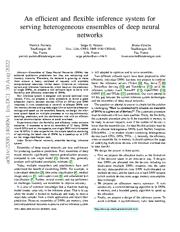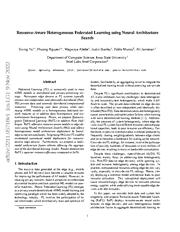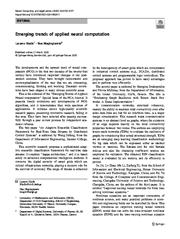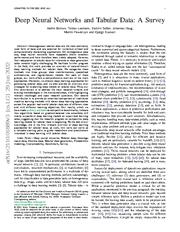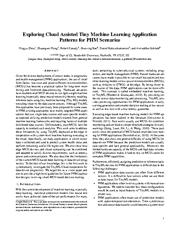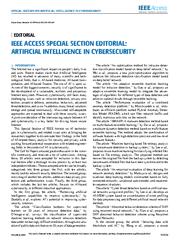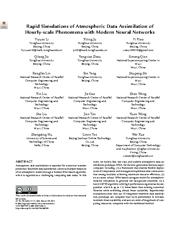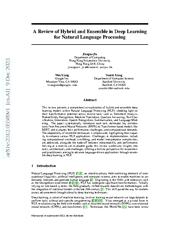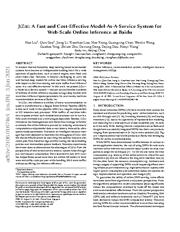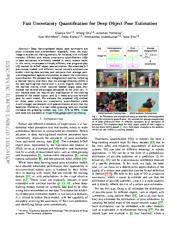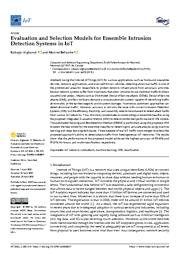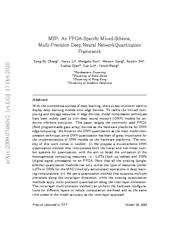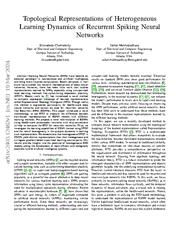A copy of this work was available on the public web and has been preserved in the Wayback Machine. The capture dates from 2022; you can also visit the original URL.
The file type is application/pdf.
Filters
An efficient and flexible inference system for serving heterogeneous ensembles of deep neural networks
[article]
2022
arXiv
pre-print
Ensembles of Deep Neural Networks (DNNs) have achieved qualitative predictions but they are computing and memory intensive. ...
Unlike recent initiatives on inference servers and inference frameworks, which focus on the prediction of single DNNs, we propose a new software layer to serve with flexibility and efficiency ensembles ...
Acknowledgement: We would like to thank TotalEnergies SE and its subsidiaries for allowing us to share this material and make available the needed resources. ...
arXiv:2208.14049v1
fatcat:6pf56fijbzb45kdaxhxyho3hhq
Resource-Aware Heterogeneous Federated Learning using Neural Architecture Search
[article]
2024
arXiv
pre-print
Preserving user data privacy while optimizing AI/ML models in a heterogeneous federated network requires us to address data and system/resource heterogeneity. ...
RaFL allocates resource-aware specialized models to edge devices using Neural Architecture Search (NAS) and allows heterogeneous model architecture deployment by knowledge extraction and fusion. ...
Additionally, the presence of system heterogeneity, where edge devices in an FL system have different resources and computational capacities, leads to poor resource use efficiency. ...
arXiv:2211.05716v2
fatcat:lebi6inevjapfdyd35g2zxjntu
HOLMES: Health OnLine Model Ensemble Serving for Deep Learning Models in Intensive Care Units
[article]
2020
arXiv
pre-print
To address these challenges, we propose HOLMES-an online model ensemble serving framework for healthcare applications. ...
HOLMES outperforms the conventional offline batch-processed inference for the same clinical task in terms of accuracy and latency (by order of magnitude). ...
ACKNOWLEDGEMENTS This work was in part supported by the National Science Foundation award IIS-1418511, CCF-1533768 and IIS-1838042, the National Institute of Health award NIH R01 1R01NS107291-01 and R56HL138415 ...
arXiv:2008.04063v1
fatcat:lb33es3ogjgrhcbewvscgxvyla
Emerging trends of applied neural computation
2020
Neural computing & applications (Print)
Then, cost-sensitive ensemble learning techniques are applied, with regularized deep neural networks as base learners. ...
The eighth paper is entitled ''Spam Detection on Social Networks using Cost-Sensitive Feature Selection and Ensemble-Based Regularized Deep Neural Networks,'' and it is authored by Aliaksandr Barushka ...
doi:10.1007/s00521-020-04829-3
fatcat:iwcezhjsgjhdti7sxkcsl25hbi
Deep Neural Networks and Tabular Data: A Survey
[article]
2022
arXiv
pre-print
On homogeneous data sets, deep neural networks have repeatedly shown excellent performance and have therefore been widely adopted. ...
Heterogeneous tabular data are the most commonly used form of data and are essential for numerous critical and computationally demanding applications. ...
Deep neural network-based methods for heterogeneous tabular data are still inferior to machine learning methods based on decision tree ensembles for small and mediumsized data sets (less than ∼1M samples ...
arXiv:2110.01889v3
fatcat:4d4lwkzfjrb75bofncvn2x5ohi
The Future of PHM Could be Tiny under Cloud: Exploring Potential Application Patterns of TinyML in PHM Scenarios
2021
Proceedings of the Annual Conference of the Prognostics and Health Management Society, PHM
We find that MCUs and cloud com-puting can be adaptive to different kinds of machine learning models and combined in flexible ways for diverse requirement.Our work also shows limitations of current MCU-based ...
We introduce potential ap-plications where sensor readings are utilized for system health status prediction including status classification and remaining useful life regression. ...
Any opinions, findings, and conclusions or recommendations expressed in this material are those of the author(s) and do not necessarily reflect the views of these sponsors. ...
doi:10.36001/phmconf.2021.v13i1.3054
fatcat:huxa5ryk5nhj3af4oq7fe6e3p4
IEEE Access Special Section Editorial: Artificial Intelligence in Cybersecurity
2020
IEEE Access
The article ''An empirical evaluation of deep learning for network anomaly detection,'' by Malaiya et al., designs and examines deep learning models constructed based on fully connected networks, variational ...
He has also served as an ACM SIGSAC awards committee member, an Associate Editor for the ACM Transactions on Information and System Security, the Journal of Computer Security, the Journal of Information ...
doi:10.1109/access.2020.3021604
dblp:journals/access/ChenQCYLPZS20
fatcat:mjvkkgt3wjfo3ditb4eibdc3s4
Rapid simulations of atmospheric data assimilation of hourly-scale phenomena with modern neural networks
2023
Proceedings of the International Conference for High Performance Computing, Networking, Storage and Analysis
Liheng for his guidance. This work is partially supported by Laoshan Laboratory (No. LSKJ202202100), the Major Key Project of PCL (No. ...
PCL2022A05), the National Key RD Program of China (No. 2020YFB0204800), National Natural Science Foundation of China (No. U2242210) and the China Postdoctoral Science Foundation (No. 2023M731955). ...
Since our model is trained for 3hour predictions, we used the neural network to perform two and four consecutive inferences for the 6-hour and 12-hour forecasts, respectively. ...
doi:10.1145/3581784.3607031
fatcat:szmechrrazgezhtqwvhgzincli
A Review of Hybrid and Ensemble in Deep Learning for Natural Language Processing
[article]
2023
arXiv
pre-print
This review presents a comprehensive exploration of hybrid and ensemble deep learning models within Natural Language Processing (NLP), shedding light on their transformative potential across diverse tasks ...
The paper systematically introduces each task, delineates key architectures from Recurrent Neural Networks (RNNs) to Transformer-based models like BERT, and evaluates their performance, challenges, and ...
For instance, an ensemble could include a combination of convolutional neural networks (CNNs), recurrent neural networks (RNNs), and transformers, each contributing to capturing different linguistic features ...
arXiv:2312.05589v1
fatcat:wjqejbp5fbhsjbkukwq4jngdsy
JIZHI: A Fast and Cost-Effective Model-As-A-Service System for Web-Scale Online Inference at Baidu
[article]
2021
arXiv
pre-print
In modern internet industries, deep learning based recommender systems have became an indispensable building block for a wide spectrum of applications, such as search engine, news feed, and short video ...
However, it remains challenging to carry the well-trained deep models for online real-time inference serving, with respect to the time-varying web-scale traffics from billions of users, in a cost-effective ...
For instance, neural collaborative filtering for user-item interaction modeling [14] , recurrent neural network for sequential user behavior modeling [15, 30] , and deep reinforcement learning for long-term ...
arXiv:2106.01674v1
fatcat:zogjjhrfezc3pkboekw56ebf5y
Fast Uncertainty Quantification for Deep Object Pose Estimation
[article]
2021
arXiv
pre-print
We ensemble 2-3 pre-trained models with different neural network architectures and/or training data sources, and compute their average pairwise disagreement against one another to obtain the uncertainty ...
In this work, we propose a simple, efficient, and plug-and-play UQ method for 6-DoF object pose estimation. ...
ACKNOWLEDGEMENT We would like to thank members of the NVIDIA AI Algorithms research team for their constructive feedback and Nathan Morrical for his help with the NViSII renderer. ...
arXiv:2011.07748v3
fatcat:ztf7imjlefehxnr33ca3bfdnju
Evaluation and Selection Models for Ensemble Intrusion Detection Systems in IoT
2022
IoT
However, accuracy is not only the issue with current Intrusion Detection Systems (IDS), but the efficiency, flexibility, and scalability need to be enhanced to detect attack traffic from various IoT networks ...
and deep learning techniques. ...
Conflicts of Interest: The authors declare no conflict of interest. ...
doi:10.3390/iot3020017
fatcat:b35kzrauxnd5bdh2qlispr4gcu
MSP: An FPGA-Specific Mixed-Scheme, Multi-Precision Deep Neural Network Quantization Framework
[article]
2020
arXiv
pre-print
To tackle the limited computing and storage resources in edge devices, model compression techniques have been widely used to trim deep neural network (DNN) models for on-device inference execution. ...
the utilization of the heterogeneous computing resources, i.e., LUTs (look up tables) and DSPs (digital signal processors) on an FPGA. ...
Introduction Deep neural networks (DNNs) have been employed in various of tasks with outstanding performance, such as convolutional neural networks (CNNs) for computer vision [1] , recurrent neural networks ...
arXiv:2009.07460v2
fatcat:di2gecaxhbejrcitjlcesau3ta
Topological Representations of Heterogeneous Learning Dynamics of Recurrent Spiking Neural Networks
[article]
2024
arXiv
pre-print
Though useful, this method is engineered particularly for feedforward deep neural networks and cannot be used for recurrent networks like Recurrent SNNs (RSNNs). ...
Our results provide insights into the potential of heterogeneous SNN models, aiding the development of more efficient and biologically plausible hybrid artificial intelligence systems. ...
The views and conclusions contained in this document are those of the authors and should not be interpreted as representing the official policies, either expressed or implied, of the Army Research Office ...
arXiv:2403.12462v1
fatcat:pbgwmxduwjh6ldhe5xjetvgnca
Machine Learning Systems for Intelligent Services in the IoT: A Survey
[article]
2020
arXiv
pre-print
This survey moves beyond existing ML algorithms and cloud-driven design to investigate the less-explored systems, scaling and socio-technical aspects for consolidating ML and IoT. ...
With a multi-layered framework to classify and illuminate system design choices, this survey exposes fundamental concerns of developing and deploying ML systems in the rising cloud-edge-device continuum ...
Neural architecture search automates and optimizes the process of finding good network architectures for deep learning models. ...
arXiv:2006.04950v3
fatcat:xrjcioqkrrhpvgmwmutiajgfbe
« Previous
Showing results 1 — 15 out of 3,661 results

